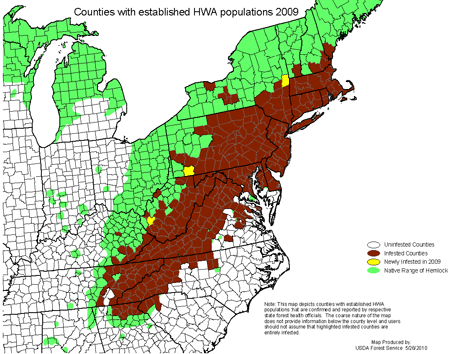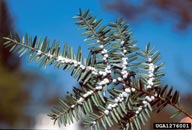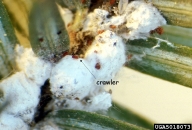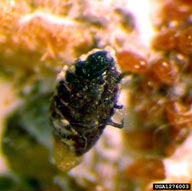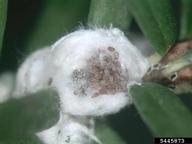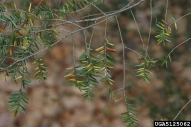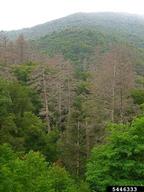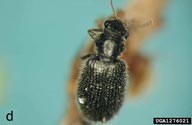Hemlock woolly adelgid
Adelges tsugae Annand (Hemiptera: Adelgidae)
Orientation to pest
Hemlock woolly adelgid, Adelges tsugae Annand, is an invasive insect in eastern North America. DNA evidence suggests that the invasive eastern U.S. population came from Japan and not the western United States, where the species is also present. Hemlock woolly adelgids are small in size and to the naked eye only their woolly coverings are easily visible. The insect has two generations per year and growth occurs from fall through late spring. Insects in summer are inactive and scarcely visible at the bases of needles as black dots. Woolly masses (the sign allowing the species to be recognized) develop in October and are present thereafter through June of the following year. In the western United States, A. tsugae feeds on western hemlock (Tsuga heterophylla [Raf.] Sarg.) but is believed to be native and is not a pest. In the eastern USA, hemlock woolly adelgid is killing eastern (Tsuga canadensis [L.] Carrière) and Carolina (Tsuga caroliniana Engelm.) hemlocks in large numbers from Connecticut south along the Appalachian Mountains. From Massachusetts north, or at high elevations, tree mortality has been restrained by higher rates of mortality of adelgids in winter due to low temperatures. A biological control program is in progress against this pest, based on specialized predatory beetles that feed only on adelgids, collected in western North America (Laricobius nigrinus Fender) or China/Japan (species of Laricobius and various Scymnus ladybird beetles). To date, releases have not demonstrated any reductions in adelgid densities from predators. Populations of L. nigrinus have become well established and abundant in some areas of western North Carolina.
Hosts commonly attacked
In North America, this species feed only on eastern hemlock (T. canadensis), Carolina hemlock (T. caroliniana), and western hemlock (T. heterophylla).
Distribution
The hemlock woolly adelgid is found as a native species in the western United States in the Pacific northwestern states (Oregon, Washington, Idaho, Montana) and as an invasive species from Japan in the eastern United States, from southern Maine to northern Georgia.
| Figure 1. Distribution of hemlock woolly adelgid, Adelges tsugae, in the eastern United States in 2009 |
Images of hemlock woolly adelgid
| Figure 2. Hemlock woolly adelgid, Adelges tsugae, on hemlock | Figure 3. Individuals of hemlock woolly adelgid covered with white wool (see crawler emerging, arrow) | Figure 4. High magnification of the aphid-like body of an adult hemlock woolly adelgid after removal of the wool |
| Figure 5. Eggs of hemlock woolly adelgid (wool pulled aside for viewing) | Figure 6. Damage from hemlock woolly adelgid is seen as needle loss, leading to branch death | Figure 7. Dead or dying hemlock in Joyce Kilmer area, North Carolina due to hemlock woolly adelgid feeding | Figure 8. Laricobius nigrinus, which feeds only on adelgids, is the most promising agent released so far against hemlock woolly adelgid |
Important biological control agents related to this pest species
There is an on going classical biological control project against this pest. As of 2010, the principal species introduced against this pest have been the following four species: Sasajiscymnus tsugae (Sasaji and McClure) (Coleop.: Coccinellidae), Scymnus sinuanodulus Yu and Yao (Coleop.: Coccinellidae), Scymnus ningshanensis Yu and Yao (Coleop.: Coccinellidae), and Laricobius nigrinus Fender (Coleop.: Derodontidae).
Web links for information on hemlock woolly adelgid
- Biological Control Links | USDA Forest Service, FHP Northeastern Area
- Forest Health Fact Sheet | State of Pennsylvania - Department of Conservation and Natural Resources
PDF with annual life cycle diagram - Pest Alert Fact Sheet | USDA Forest Service, Northeastern Area
Articles
- Zilahi-Balogh, G. M. G., L. T. Kok, and S. M. Salom. 2002. Host specificity of Laricobius nigrinus Fender (Coleoptera: Derodontidae), a potential biological control agent of the hemlock woolly adelgid, Adelges tsugae Annand (Homoptera: Adelgidae). Biological Control 24: 192-198.
- Zilahi-Balogh, G. M. G., S. M. Salom, and L. T. Kok. 2003. Development and reproductive biology of Laricobius nigrinus, a potential biological control agent of Adelges tsugae. BioControl 48: 293-306.
- Mausel, D. L., S. M. Salom, L. T. Kok, and G. A. Davis. 2010. Establishment of the hemlock woolly adelgid predator, Laricobius nigrinus (Coleoptera: Derodontidae), in the eastern United States. Environmental Entomology 39: 440-448.
- Krapfl, K. J., E. J. Holzmueller, and M. A. Jenkins. 2011. Early impacts of hemlock woolly adelgid in Tsuga canadensis forest communities of the southern Appalachian Mountains. Journal of the Torrey Botanical Society 138: 93-106.
- Montgomery, M. E., S, Shiyake, S., N. P. Havill, and R. A. B. Leschen, 2011. A new species of Laricobius (Coleoptera: Derodontidae) from Japan with phylogeny and a key for native and introduced congeners in North America. Annals of the Entomological Society of America 104: 389-401.
